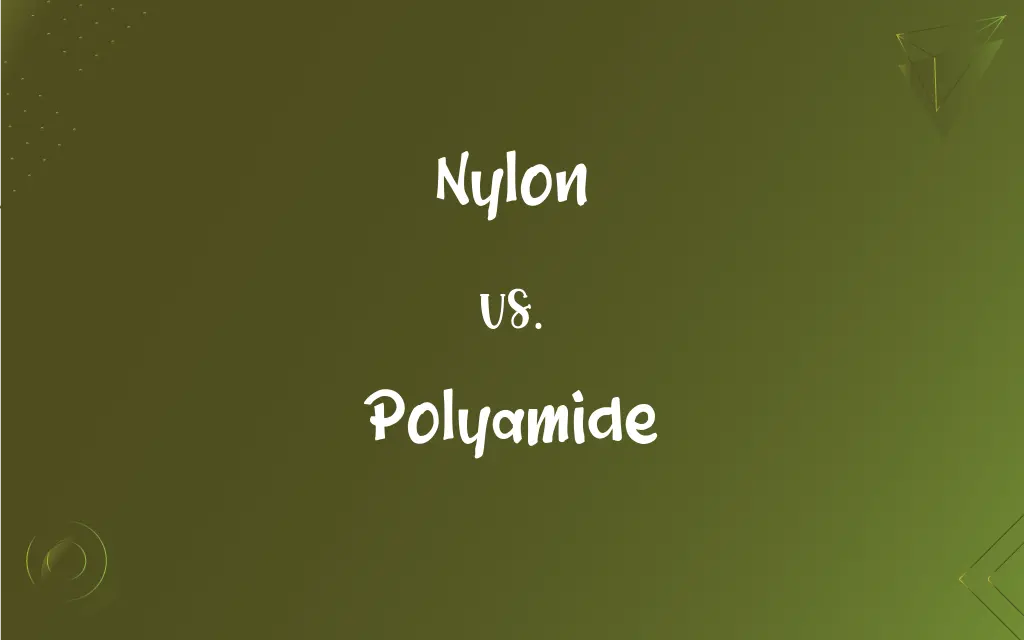Nylon vs. Polyamide: What's the Difference?
Edited by Aimie Carlson || By Janet White || Published on December 8, 2023
Nylon is a type of synthetic polymer known as a polyamide, used in fabrics and plastics, while polyamide is a broader category of polymers including but not limited to nylon.

Key Differences
Nylon is a specific type of polyamide, characterized by its strength, elasticity, and resistance to abrasion and chemicals. It was the first commercially successful synthetic thermoplastic polymer. Polyamide refers to a group of polymers that contain amide linkages, with nylon being the most famous and widely used example. However, there are other types of polyamides with varying properties.
In terms of applications, nylon is widely used in textiles, automotive parts, and consumer goods. It is known for its ability to be drawn into fine threads and its durability. Polyamides, more broadly, can be found in a wider range of applications including engineering plastics, where different types of polyamides like Kevlar offer different properties such as high heat resistance or exceptional strength.
The production process of nylon involves the polymerization of specific monomers, like adipic acid and hexamethylene diamine. This process results in nylon types like Nylon 6,6 or Nylon 6. In contrast, polyamides can be produced through various polymerization processes involving different monomers, resulting in a diverse group of materials with a range of properties.
In terms of environmental impact, nylon production is energy-intensive and contributes to environmental concerns due to its non-biodegradable nature. However, efforts are underway to recycle and make more sustainable forms of nylon. Other polyamides may also have environmental impacts, but these can vary significantly depending on the type of polyamide and its production process.
Nylon is often used in everyday language to refer specifically to materials made from this polymer, particularly in textiles. Polyamide, while less commonly used in everyday language, is a term more familiar in scientific and industrial contexts, representing a broader category of materials that includes but is not limited to nylon.
ADVERTISEMENT
Comparison Chart
Definition
A specific type of polyamide
A group of polymers including nylon
Applications
Textiles, consumer goods, automotive parts
Broad range, including textiles, engineering plastics
Production
Polymerization of specific monomers like adipic acid
Various polymerization processes with different monomers
Environmental Impact
Non-biodegradable, energy-intensive production
Varies by type; some more sustainable than nylon
Common Usage
Commonly referred to in textiles
More a scientific or industrial term
ADVERTISEMENT
Nylon and Polyamide Definitions
Nylon
Known for strength and elasticity.
Nylon ropes are preferred for climbing due to their strength.
Polyamide
Contains amide linkages in the polymer chain.
The strength of polyamides is partly due to their unique molecular structure.
Nylon
A synthetic polymer used in textiles and plastics.
The jacket was made of durable nylon, perfect for outdoor activities.
Polyamide
Used in a wide range of applications.
Polyamides like Kevlar are used in bulletproof vests.
Nylon
Resistant to abrasion and chemicals.
Nylon fabrics are used in swimwear for their chemical resistance to chlorine.
Polyamide
A group of polymers including nylon.
Polyamide materials are used extensively in automotive parts.
Nylon
Used in fine threads for various applications.
She chose sheer nylon curtains for the living room.
Polyamide
Can be produced through various polymerization processes.
Different manufacturing techniques lead to different types of polyamides.
Nylon
First commercially successful synthetic thermoplastic polymer.
Nylon revolutionized the textile industry in the 20th century.
Polyamide
Varies in environmental impact and sustainability.
Newer forms of polyamide are being developed to be more eco-friendly.
Nylon
Any of a family of high-strength, resilient synthetic polymers, the molecules of which contain the recurring amide group CONH.
Polyamide
A polymer containing repeated amide groups, as in various kinds of nylon.
Nylon
Cloth or yarn made from one of these synthetic materials.
Polyamide
(chemistry) Any of a range of polymers containing amide (or peptide) repeat units; examples include proteins and nylon.
Polyamide
A polymer containing repeated amide groups
FAQs
What are common uses of nylon?
Common uses include clothing (like hosiery and swimwear), ropes, carpets, and toothbrush bristles.
Can nylon be recycled?
Yes, nylon can be recycled, though the process can be complex.
Is nylon waterproof?
Nylon is not inherently waterproof but is water-resistant and dries quickly.
Is nylon biodegradable?
No, nylon is not biodegradable and can take decades to decompose.
How was nylon first created?
Nylon was first synthesized in 1935 by Wallace Carothers at DuPont.
What are the characteristics of polyamide?
Characteristics include high strength, elasticity, and resistance to abrasion and chemicals.
Are all polyamides the same as nylon?
No, while nylon is a well-known type of polyamide, there are other polyamides with different properties.
What is nylon?
Nylon is a synthetic polymer, specifically a type of polyamide, known for its strength, elasticity, and resistance to wear.
Is nylon environmentally friendly?
The production of nylon is energy-intensive and not very environmentally friendly.
Can nylon melt?
Yes, nylon can melt at high temperatures.
How is nylon made?
Nylon is made through a chemical process called polymerization, involving the reaction of diamine acid with dicarboxylic acid.
What are the disadvantages of nylon?
Disadvantages include sensitivity to UV light, proneness to static electricity, and environmental concerns.
Can polyamides conduct electricity?
Polyamides are typically poor conductors of electricity.
What is the difference between polyamide and polyester?
The main difference lies in their chemical structure; polyesters are polycondensation products of dicarboxylic acids and diols, while polyamides are from amide linkages.
What is polyamide?
Polyamide is a type of polymer containing amide bonds, encompassing a range of materials including plastics and fibers.
Is nylon a polyamide?
Yes, nylon is a type of polyamide.
How are polyamides produced?
Polyamides are produced through a condensation polymerization process, forming long chains from monomers.
Are polyamides used in automotive parts?
Yes, due to their strength and thermal stability, polyamides are often used in various automotive components.
Are polyamides safe for skin contact?
Generally, yes. Polyamides used in clothing are safe for skin contact.
How are polyamides used in textiles?
In textiles, polyamides are used for their durability, elasticity, and resistance to wrinkles and stains.
About Author
Written by
Janet WhiteJanet White has been an esteemed writer and blogger for Difference Wiki. Holding a Master's degree in Science and Medical Journalism from the prestigious Boston University, she has consistently demonstrated her expertise and passion for her field. When she's not immersed in her work, Janet relishes her time exercising, delving into a good book, and cherishing moments with friends and family.
Edited by
Aimie CarlsonAimie Carlson, holding a master's degree in English literature, is a fervent English language enthusiast. She lends her writing talents to Difference Wiki, a prominent website that specializes in comparisons, offering readers insightful analyses that both captivate and inform.































































